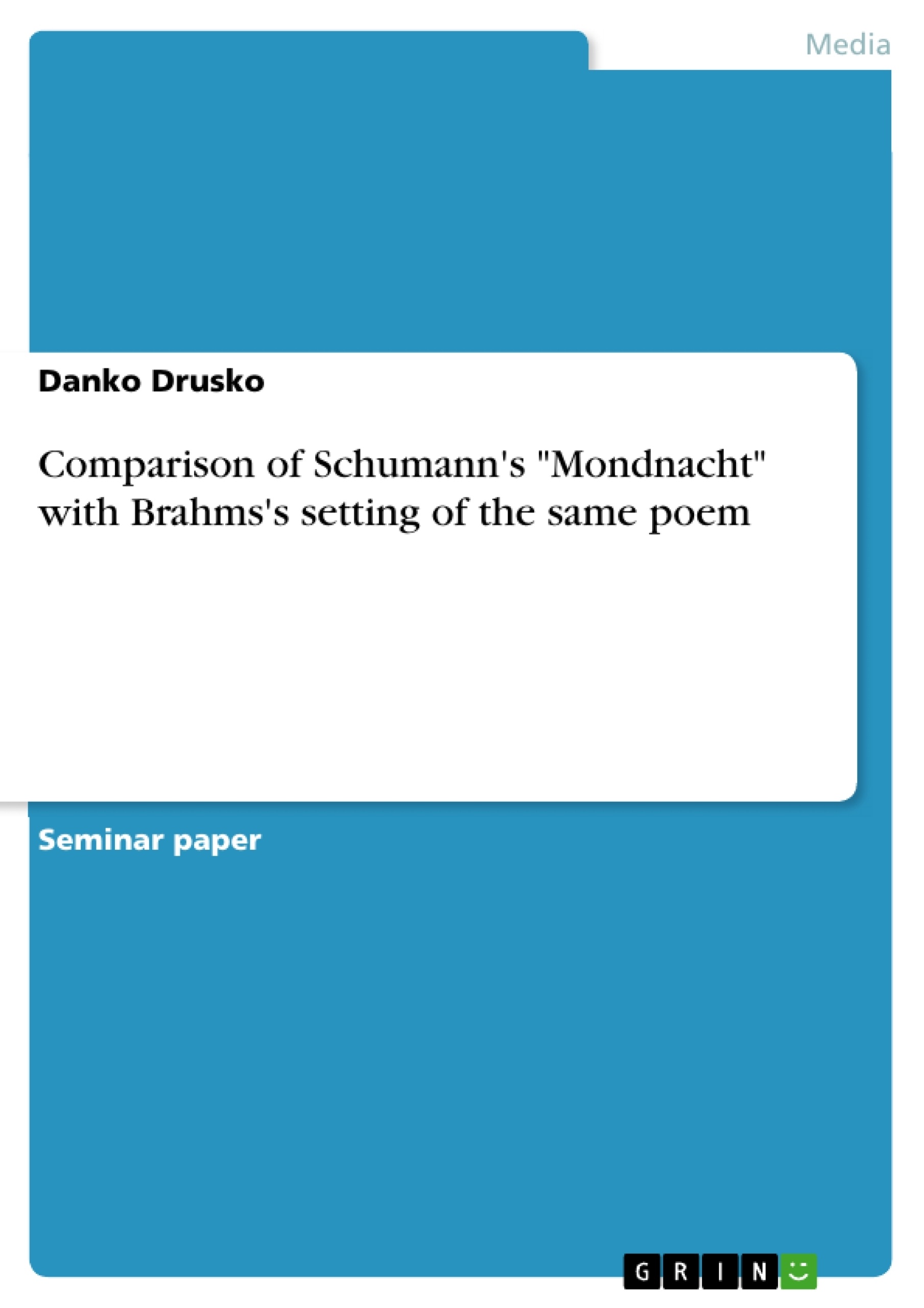To precede my comparison of Schumann's "Mondnacht" and Brahms's setting of the same poem I would like to begin with a brief introduction of the two composers. Their personal histories will be taken into account in order to show if any conclusions can be drawn on how their approaches to the compositions may have been influenced. I will also concentrate particularly on both composers’ roles in the context of the Lied of the 19th century. Within this context I will provide a short introduction to the poem Mondnacht and address its various different settings. In this approach will be considered both musical, as well as textual content. By the end of the paper I hope to provide a clearer understanding of how each of them composed their work and illuminate several differences and similarities. In order to not translate each quote taken from German sources and due to my German background I will be using the original quotes.
Inhaltsverzeichnis (Table of Contents)
- 1. Introduction
- 2. Robert Schumann
- 2.1 Schumann in the context of das Lied
- 3. Johannes Brahms
- 3.1 Brahms in the the context of das Lied
- 4. Mondnacht by Eichendorff
- 5. Schumann's setting of Mondnacht
- 6. Brahm's setting of Mondnacht compared to Schumann's
Zielsetzung und Themenschwerpunkte (Objectives and Key Themes)
This paper aims to compare Schumann's and Brahms's settings of Eichendorff's poem "Mondnacht". It will explore their individual approaches to composing Lieder, considering their personal histories and their role in the context of the Lied of the 19th century. The paper will also analyze the musical and textual content of the poem and its various settings.
- The development of the Lieder genre in the 19th century
- The influence of poetry on musical composition
- The role of the piano accompaniment in Lieder
- The unique approaches of Schumann and Brahms to setting poetry to music
- A comparison of the musical and textual interpretations of "Mondnacht" by Schumann and Brahms
Zusammenfassung der Kapitel (Chapter Summaries)
- Chapter 2: Robert Schumann: This chapter introduces Robert Schumann, discussing his upbringing, musical training, and early career. It highlights his role in the development of the Lieder genre and his contributions to the musical aesthetics of the time. It also explores his relationship with Clara Wieck and his most prolific years of composition.
- Chapter 2.1: Schumann in the context of das Lied: This chapter discusses Schumann's role in the evolution of the Lieder genre, emphasizing his connection to the poetic and romantic sensibilities of the 19th century. It analyzes how Schumann elevated the Lieder to a major genre through his innovative approach to musical accompaniment and his focus on conveying the nuances of the text.
- Chapter 3: Johannes Brahms: This chapter will provide an introduction to Johannes Brahms, exploring his life, musical training, and his significant contributions to the Lieder genre. It will highlight his unique approach to setting poetry to music and his role in shaping the musical landscape of the 19th century.
- Chapter 3.1: Brahms in the context of das Lied: This chapter will delve into Brahms's role in the development of the Lieder genre, emphasizing his connection to the poetic and romantic sensibilities of the 19th century. It will analyze his approach to musical accompaniment, his emphasis on text interpretation, and his unique contribution to the Lieder tradition.
- Chapter 4: Mondnacht by Eichendorff: This chapter will provide an introduction to Eichendorff's poem "Mondnacht," discussing its themes, imagery, and significance in German literature. It will analyze the textual content and its potential for musical interpretation.
- Chapter 5: Schumann's setting of Mondnacht: This chapter will analyze Schumann's musical setting of "Mondnacht," exploring his interpretation of the poem's themes, imagery, and overall mood. It will examine his use of musical elements, such as melody, harmony, and rhythm, to convey the emotional and poetic content of the text.
- Chapter 6: Brahm's setting of Mondnacht compared to Schumann's: This chapter will compare Brahms's setting of "Mondnacht" to Schumann's, focusing on the similarities and differences in their approaches to interpreting the poem. It will analyze their distinct musical styles, their use of melody, harmony, and rhythm, and their overall interpretations of the text.
Schlüsselwörter (Keywords)
This paper focuses on the Lieder genre, specifically exploring the works of Robert Schumann and Johannes Brahms. The paper examines the influence of poetry on musical composition, the role of the piano accompaniment in Lieder, and the unique approaches of Schumann and Brahms to setting poetry to music. The analysis centers on the poem "Mondnacht" by Joseph von Eichendorff and its musical settings by Schumann and Brahms, highlighting their distinct interpretations of the text and their musical styles.
- Quote paper
- Danko Drusko (Author), 2011, Comparison of Schumann's "Mondnacht" with Brahms's setting of the same poem, Munich, GRIN Verlag, https://www.hausarbeiten.de/document/183221



